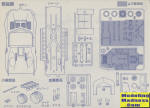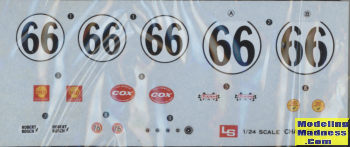
LS 1/24 Chaparral 2C
| KIT #: | 2267 |
| PRICE: | $37.00 delivered |
| DECALS: | One option |
| REVIEWER: | Scott Van Aken |
| NOTES: | Curbside |

| HISTORY |
The Chaparral 2C is a sports prototype race car designed and developed by both Jim Hall and Hap Sharp, and built by American manufacturer Chaparral in October 1965, to compete in a few non-championship sports car races that same year.The 2C introduced the innovative in-car adjustable rear wing. The integrated spoiler-wing was designed to lie flat for low drag on the straights and tip-up under braking through the corners. The car's clutchless, semi-automatic transmission kept the driver's left foot free to operate the wing mechanism. The 2C was based on a Chevrolet-designed aluminum chassis and was a smaller car in every dimension than the 2B. Without the natural non-resonant damping of the fiberglass chassis, Hap Sharp nicknamed it the EBJ — "eyeball jiggler".
| THE KIT |
 Initially
released in 1967, the kit has been reissued a number of times, some of these
including new parts to make the kit more accurate. This is the last LS
release from the 1980s, though ARII, who bought the LS catalogue, reissued
it in 2001. I bought this from a seller in Japan after a Facebook seller
offered it at what I though was a ridiculous price. When I see things like
that, I always research it to see if I can get it for less.
Initially
released in 1967, the kit has been reissued a number of times, some of these
including new parts to make the kit more accurate. This is the last LS
release from the 1980s, though ARII, who bought the LS catalogue, reissued
it in 2001. I bought this from a seller in Japan after a Facebook seller
offered it at what I though was a ridiculous price. When I see things like
that, I always research it to see if I can get it for less.  Instructions
are nicely drawn and provide Gunze paint references. All of the
writing in the instructions is in Japanese, but this won't be an issue. The
car is overall white with a black interior. Since there are no chrome bits,
one will need to paint the wheels and intake bits with aluminum. Though it
is old, the decal sheet looks to be still viable. Those who want to improve
the look of the model might want to consider cutting away all the molded in
screening and replacing it with actual screen material, but that is up to
the builder.
Instructions
are nicely drawn and provide Gunze paint references. All of the
writing in the instructions is in Japanese, but this won't be an issue. The
car is overall white with a black interior. Since there are no chrome bits,
one will need to paint the wheels and intake bits with aluminum. Though it
is old, the decal sheet looks to be still viable. Those who want to improve
the look of the model might want to consider cutting away all the molded in
screening and replacing it with actual screen material, but that is up to
the builder.
| CONCLUSIONS |
I have always liked the Chaparral. They piqued my racing car crazy interest when I was considerably younger and while there have been kits of the various versions, most of them have been overly expensive. I was able to get a 2D kit back when it was reissued by Fujimi and you can read about that in the archives. I'll definitely be building this one to add to the collection.
| REFERENCES |
http://en.wikipedia.org
Copyright ModelingMadness.com. All rights reserved. No
reproduction in part or in whole without express permission from the editor.
If you would like your product reviewed fairly and fairly quickly, please contact the editor or see other details in the Note to Contributors.